8 Facts of Odessa Port You Might Not Know
The Black sea is situated between the continents of Asia and Europe. It borders the nations of Bulgaria, Georgia, Romania, Russia, Turkey, and Ukraine. Connected to the Atlantic ocean through the Mediterranean and the Aegean Sea, it is a crucial maritime waterway enabling the transportation of a variety of goods. Apart from being one of the busiest shipping routes in the world, the Black sea region has a prosperous tourism and fisheries sector.
Around 65 seaports and numerous small river ports are situated along its coast, connecting the Mediterranean region with Eastern Europe and Asia. Let us explore some interesting facts about one of the biggest and busiest ports of the Black sea, the Port of Odessa.
1. Odessa is the largest seaport of Ukraine
The Port of Odessa is located on the northwestern coast of the Black sea, in the southwestern end of Odesa Bay, about 150 kilometers from the Romanian border. The modern port was opened in 1974 and is owned by the Ukrainian Sea Ports Authority. It covers 141 hectares of the land area comprising 46 berths and a total of 54 wharves, divided among its many specialized cargo handling facilities and harbors, screened off from the open sea by a few long breakwaters.
With alongside depths ranging from 7 m to 11.5 m, and a 9000 m berthing line, Odessa port can accommodate ships with a maximum LOA of 330 m, a breadth of 40 m, and a 13 m draft. Specifically, LASH vessels are handled at the refurbished Karantinny mole while the Voyennyy Mole can simultaneously accommodate six-ocean going liners.
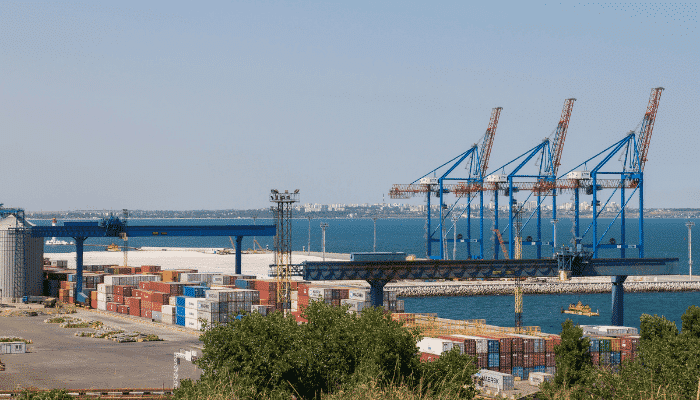
The port is operational throughout the year however ice-breaker assistance is needed during the chilling winter months. Though it has a well-sheltered harbor, it faces the strongest winds blowing from the north. It is protected by numerous moles on the eastern side and by jetties of the oil harbor in the north.
The largest seaport of Ukraine, it has an annual cargo capacity of 40 million tonnes including 15 million tonnes of dry cargo and 25 million tonnes of liquid bulk. Although it is a multifunctional port dealing with a variety of export and import commodities, it is known as a major gain export facility in the Mediterranean region.
Odessa port handled 22.56 million tonnes of cargo including 19.987 million tonnes of dry bulk, a 3.4 percent decrease compared to the previous year and a 2.9
% growth in container traffic as it handled 671,532 TEUs in 2021, according to the country’s Port Authority. The major items handled were grains, container goods, and ferrous metals.
The port is directly linked to the country’s national railway network and the main expressway, aiding the faster transfer of cargo from the port area to the major cities of the region.
2. Houses seven modern and well-planned cargo terminals
Odessa’s container terminal is equipped with the latest tracking system offering real-time container tracking and a fully automated scanning system thereby enabling faster processing. It can handle more than 900,000 TEU annually on its five dedicated berths capable of receiving the world’s largest container ships. Container cleaning, stuffing, and stripping are other services offered by the facility.
Adjacent to the container terminal is a Special Economic Zone built on the port’s quarantine pier, covering three kilometers. Also known as a free port, it became operational in 2003, to attract foreign businesses and overseas investment, create new jobs, forge strong foreign economic relations, and aid in the further infrastructural and technological development of Odessa port.
The Transit-cargo facility operates throughout the day and has a six-hour turnaround time on the containers passing through Odessa. It has three warehouses spanning 2000 m2 each with a capacity for 3700 packages or pallets. These storage units can serve 10 port trucks at once and are endowed with state-of-the-art security measures, advanced fire protection, and a proper ventilation system.
Universal Handling Complex, also known as PHC Complex was opened in 2003 to handle metal goods, general cargo, sawn timber, breakbulk, packaged food, and Roro. It has seven piers with lengths ranging from 170 to 190 m with a 10 m alongside depth for accommodating heavyweight cargoes. PHC-7 is especially busy since it deals with shipments of bulk grains, iron ores, ferroalloys, cast iron, and rolled metals. Berth 4 is linked to a complex network of oil pipelines as it deals with vegetable and tropical oils along with bulk fats.
3. Odessa port contains one of the oldest shipyards of Ukraine
Founded from the Admiralty Shops of the Black sea fleet a few years before the establishment of the port city, the Ukraina Shipyard covers 75,524 m2 and can accommodate vessels with a maximum displacement of up to 30,000 tonnes. It was the supporting base of the Black Sea Shipping Company during the cold war era and some of the mightiest ships of the USSR were repaired in this facility.
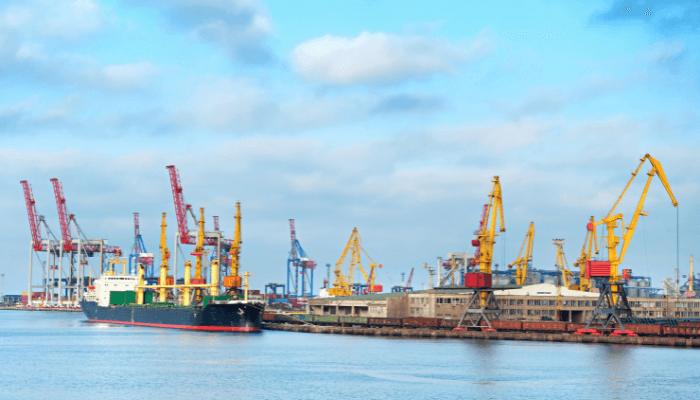
Presently, commercial maritime vessels of all nations are welcome at this shipyard. It has a total pier length of 1230 m whereas the 5 ship-repair berths span more than 600 m with alongside depths of 7.2 m. Equipped with six 10 to 30-tonne gantry cranes, 2 floating cranes with a maximum lifting capacity of 100 tons, ample maintenance equipment, a railway spur line and painting workshops, it is one of the busiest ship maintenance and repair facilities in the country.
4. Has the biggest oil and gas terminal of Ukraine
Sometimes referred to as the OMTP Oil district, the oil and gas facility is located in the eastern part of the main port area dealing with 15,000 tonnes of crude oil, 6,200,000 tonnes of fuel oil, 2,500,000 tonnes of diesel, 800,000 tonnes of gasoline and vacuum gas oil etc.
Possessing an annual capacity of 25,550,000 tonnes, it is equipped with a high-security system to prevent any major accidents or oil leakages. An oil collector and a ballast water treatment plant are situated in the vicinity of this terminal.
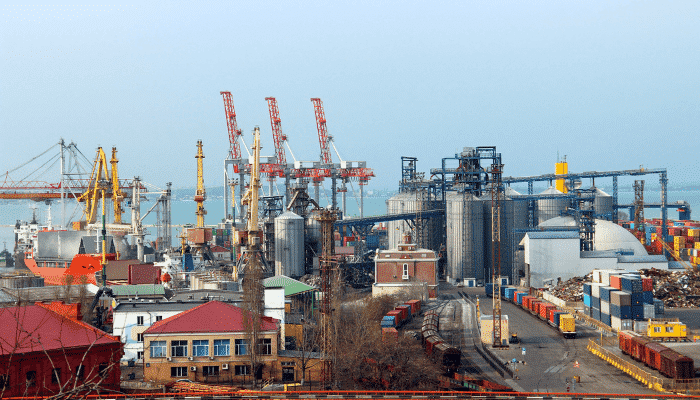
Comprising six wharves with a total storage capacity of over 61,000 m3, it serves several oil and gas companies such as the Odesnaftoprodukt, a prominent state-owned enterprise, and Synthes Oil, which regularly ships liquified gas. The oil district can accommodate oil tankers with load capacities from 1000 tons to 100,000 tonnes.
Additionally, it has 2 designated piers for handling natural gas, propane, and butane and also a reservoir farm lying a few miles from the port harbor. An oil reservoir can hold more than 6500m3 of oil whereas the terminal can handle approximately 700,000 tonnes of liquified natural gas every year. Fuel goods are transported to the fuel depots through an intricate network of oil pipelines.
As per news reports, the Russian military targeted the crucial infrastructure of the Odessa port. The oil processing plant and numerous fuel depots around the strategic Black seaport were bombed by the Russian naval ships and aircraft on 3rd April 2022 to prevent the Ukrainian troops from getting access to fuel and oil.
5. Odessa port boasts one of the finest passenger terminals in the world
Situated in the heart of the city’s historic province, the Odessa Passenger terminal is a rather luxurious facility offering extreme comfort. Its beautiful waterfront is just four kilometers from the central railway station and the international airport. An entertainment hub in itself, it contains a marine art gallery, a four-star hotel complex, a concert and exhibition hall, offices of prominent travel agencies, and a yacht complex.
Around 4 million tourists arrive at the terminal every year from the United States, Britain, Norway, Germany, and Italy. Capable of mooring even the biggest cruise ships, the passenger terminal can accommodate five maritime vessels at once on its 7 passenger wharves spanning 1370 m with depths ranging from 10 to 11.5 m respectively. Inside the terminal are waiting rooms, air-conditioned lounges, cafes and bars, a food court, a helpdesk, etc. Banking, railway, and air ticketing services are also available for the convenience of passengers.
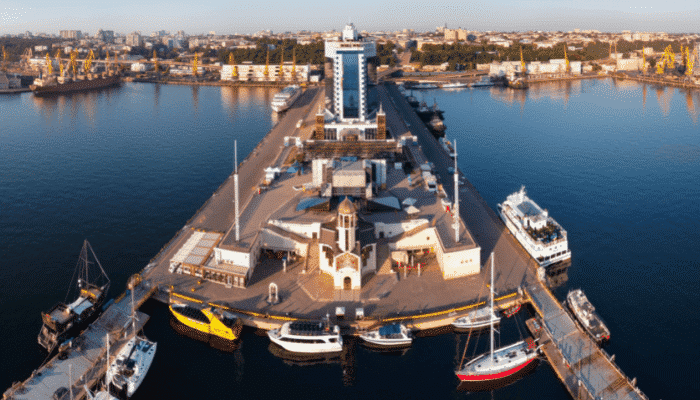
The Concert and Exhibition hall at the Port of Odessa spans 4000 sq m. Having a seating capacity of 500 people, it is decked with an Electro-Voice sound system and hosts one of the most exciting music shows and a summer music festival.
Another exciting venue is the Diving Centre which offers thrilling underwater excursions to over 50 sunken ships, scuba-diving, and swimming. Equipment can be taken on hourly rental and even a personal instructor can be hired.
The Marine art gallery covers 1070 sq m and holds interesting exhibitions themed on aquatic life. It contains paintings, sculptural depictions, and also graphic arts created by artists from Ukraine and other nations. Lying near the shoreline, it offers a charming view of the sea. Near the gallery, is an administrative building having spacious rooms for conducting business meetings and conferences.
Lastly, the terminal also houses the St. Nicholas Church, built-in 1801 for the seamen arriving at the port of Odessa. It was refurbished in 1993 and is situated near the yacht complex. Comprising a huge library and a chapel dedicated to the patron saint of sailors, Saint Nicholas, this Church is also known for its medieval architecture.
6. Serves the industrial region of the country
Odessa is Ukraine’s fourth biggest city and home to a diverse industrial sector. It is famous for its chemical industries producing paints, natural and artificial dyes, and fertilizers. Also, several oil refineries, metalworking factories, and food processing units are located in the western part of the city. The finished products of these enterprises are exported by the Port of Odessa. Also, a few processing plants are located near the waterfront and newly constructed ones can be found near the terminal buildings.
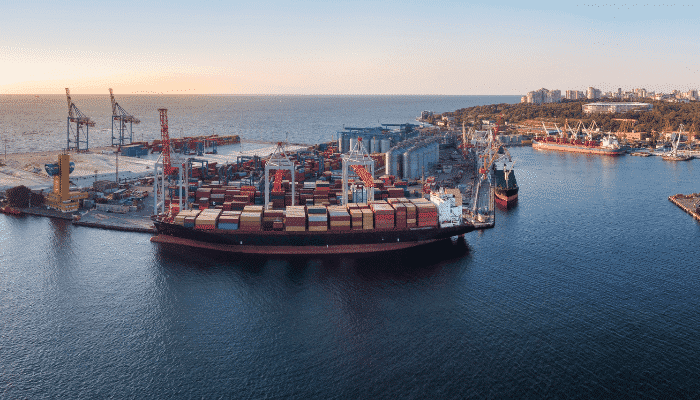
Odessa is also an important administrative, educational and cultural center of Ukraine. It has more than 20 higher educational institutions and around 80 scientific research facilities.
Odessa Port Plant is a major Ukrainian fertilizer producer and a transshipment company established in 1974 in the Port of Odessa as a part of the Soviet Union’s program for producing nitrogen fertilizers within its boundaries. Today, the plant accounts for 23% of Urea and 18% of ammonia production, making it the biggest urea manufacturer and the second-biggest ammonia producer in Ukraine. In 2020, it produced 567,000 tonnes of ammonia and 821,000 tons of carbamide.
7. One of the biggest outdoor markets of Europe is located near Odessa port
The seventh-kilometer market is made from empty containers left by a German Shipping enterprise. It is known as the biggest European market for wholesale and retail products. Interestingly, empty shipping containers are commonly utilized as market stalls and warehouses in the nations of the erstwhile Soviet Union.
It is also one of the largest open-air markets in Europe, covering around 170 hectares. Locally known as Tolchok, it has more than 16,000 vendors and 1250 security guards. All kinds of products, ranging from electronics to exquisite pieces of crockery or textiles, shoes, watches, fashionable clothing and much more can be found here. The traders sell goods in all price ranges, from authentic products to cheap household items and many counterfeit luxurious goods.
Products arrive at the Port of Odessa and are then transported to this market. Mainly imported items from China, Thailand, Indonesia, Singapore, and other Asian nations are sold at most shops. The market is owned by an offshore company that is responsible for its operations.
8. Dotted with many beautiful beaches and resorts
The port city has many serene beaches such as the Arcadia which is Ukraine’s most popular beach, close to the city center. It has a health resort, nightclubs, and seafood restaurants providing outdoor dining. Another white-sandy beach offering water slides for children and a food court is Malibu beach located in the Luzanova neighborhood. Many Hollywood movies have been shot here and it has one of the clearest waters.
Lanzheron Beach is situated near Shevchenko Park, hence people can enjoy the warm sea and the park’s greenery at the same time. It is closest to the city’s historic district and just 10 minutes away from the Opera Theatre and the Dolphinarium.
You might also like to read:
- Largest Sea in the World- 6 Facts You Might Not Know
- 8 Amazing Facts About the Black Sea
- 10 Amazing Facts About The Aral Sea
Disclaimer :
The information contained in this website is for general information purposes only. While we endeavour to keep the information up to date and correct, we make no representations or warranties of any kind, express or implied, about the completeness, accuracy, reliability, suitability or availability with respect to the website or the information, products, services, or related graphics contained on the website for any purpose. Any reliance you place on such information is therefore strictly at your own risk.
In no event will we be liable for any loss or damage including without limitation, indirect or consequential loss or damage, or any loss or damage whatsoever arising from loss of data or profits arising out of, or in connection with, the use of this website.
Do you have info to share with us ? Suggest a correction
Disclaimer :
The information contained in this website is for general information purposes only. While we endeavour to keep the information up to date and correct, we make no representations or warranties of any kind, express or implied, about the completeness, accuracy, reliability, suitability or availability with respect to the website or the information, products, services, or related graphics contained on the website for any purpose. Any reliance you place on such information is therefore strictly at your own risk.
In no event will we be liable for any loss or damage including without limitation, indirect or consequential loss or damage, or any loss or damage whatsoever arising from loss of data or profits arising out of, or in connection with, the use of this website.
Latest Maritime Knowledge Articles You Would Like:
Subscribe To Our Newsletters
By subscribing, you agree to our Privacy Policy and may receive occasional deal communications; you can unsubscribe anytime.















